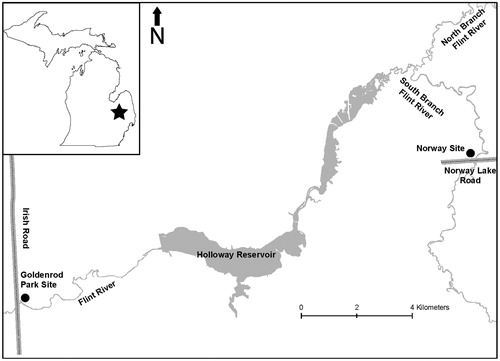Figures & data
Figure 1. Map of the Flint River showing location in Michigan (black star) and the two sampling sites (black circles), Goldenrod Park (with round gobies and zebra mussels) and the Norway site (without round gobies and zebra mussels).

Table 1. Density (no./100 m2) of darter species and round gobies at Goldenrod Park (1998 and 2002) in the Flint River, Michigan and at the Norway site upriver of the study site where round gobies and zebra mussels were absent.
Table 2. Percent composition by number (N) and volume (V) of diets of large (LG) and small (SM) round gobies (RG) Neogobius melanostomus and blackside darters (BD) Percina maculata collected during August 1998 and late August - September 2002 from the Flint River, Michigan at Goldenrod Park (GR) and the Norway site (NW).
Table 3. Schoener Index (SI - diet overlap) and Analysis of Similarity (ANOSIM) values for various comparisons of benthos data on rocks (ANOSIM values only) and diet of round gobies (RG) and blackside darters (BD) of different sizes and from different years. GR = Goldenrod Park, LG = large, SM = small, na = not applicable.
Table 4. List of the mean number of benthic organisms (standardized to 100/rock) found on rocks during 1998 (n = 135, pooled data over 4 months) (Carman et al. Citation2006) and 2002 (n = 7 per site, this study). Rocks were removed from Goldenrod Park (Goldenrod) and the Norway site upriver in the Flint River, Michigan. Rocks from 2002 were collected on 30 August (n = 3 per site) and 27 September 2002 (n = 4 per site) and data pooled.
